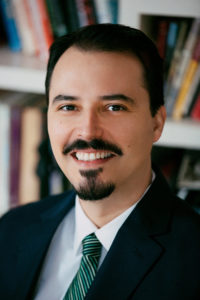• by Andres López • IDRA Newsletter • August 2019 •
 Andres López, a teacher at Stevens High School in San Antonio and winner of the statewide 2019 Outstanding Teaching of the Humanities Award, offers the following advice to educators. To contact Mr. López, email andres.lopez@nisd.net.
Andres López, a teacher at Stevens High School in San Antonio and winner of the statewide 2019 Outstanding Teaching of the Humanities Award, offers the following advice to educators. To contact Mr. López, email andres.lopez@nisd.net.
Treat Students as Equal Partners in their Learning
I expect my students, as equal partners, to take responsibility for their own learning. To that end, I structure my classes like college-level seminars and use technology to differentiate instruction and create a student-centered environment. I make all instructional materials, such as PowerPoint slides and readings, available online, allowing students to review content at their own pace. I also post extra content, like videos and articles, for students to further explore if they are interested in a particular subject. The extra content also functions as a scaffold for students struggling with a difficult text to unlock deeper meaning, and it pushes students to develop an original, unique analysis.
Teach by Learning Alongside Students and Lead by Example
Rather than only impart knowledge through lectures, I work with students side-by-side to examine and find meaning from the texts we study together. I read what they read and complete writing assignments along with them. I share my writing with my students, explain the process I used, and show them different areas I would explore if I had more time. During class discussions, I set the example by sharing my personal experiences and connecting them to the text, then invite my students to do the same.
Assign Meaningful, Challenging Tasks for Students to Demonstrate their Learning
The assignments that bring out the best in students involve a blend of academic rigor and student choice. For example, as a culminating project called Art Matters, I ask students to analyze a contemporary artistic text of their choosing – such as a song, book, film, poem, or even video game – and convey the artistic value and cultural relevance of the text through a class presentation. I ask them to articulate what sets it apart as worthy of further study. Students must use research to support and enrich their own critical analysis of the text and decipher the deeper implications within the broader context of the times in which we live. Ultimately, they must convince the class they have found art that matters. Projects like this tap into their intrinsic motivation, which is very powerful. This project often results in my students’ best work.
Be Agile!
Seek feedback from your students and adjust accordingly. Consider enhancing the productivity of professional learning communities by inviting a panel of students to present their feedback. The students become much more engaged in class, gain new insight into the process of teaching and learning, and contribute excellent ideas for assessments, interventions and lesson plans. I also use anonymous surveys collected from my students to revise my instruction. As experts in their own learning, students provide insight that is invaluable in helping me determine new approaches or techniques needed to best meet their needs and goals.
Trust and Train Students to Teach
When you recognize metacognitive and leadership talents in your students, suggest they teach an upcoming lesson. I work with my students outside of class to explain the objective of their lesson and help them plan. They take the responsibility very seriously and implement innovative ideas for delivering instruction. Students grow from the process, and some even fall in love with teaching and decide to change their intended college majors. Alyssa Diaz and Daniela Herrejon, featured on Pages 4 and 5, respectively, are examples. Their teaching experiences go beyond anything a single test can measure.
Hear our Classnotes Podcast interview featuring Andres López: Teacher Adapts Curricula to Circumvent Institutional Discrimination – Podcast Episode 183
Incorporate Culturally-Sustaining Pedagogy
I strive to develop lessons that help students realize that the stories of their own families and cultures are valuable and worthy of study. I have seen students, some seemingly disengaged from school, come alive when the right poem, short story, or piece of art activates something within them. Other texts open their eyes to the vibrant hometown history or culture they had taken for granted. One student told me my class was her first opportunity to read literature with characters that “speak like my family and me.” Representation matters.
Get to Know Students as People, Not Just Pupils
When students know you care about them holistically as individuals, their classroom achievement and enthusiasm improve tremendously. Each year, I try to go to at least one extracurricular event of each of my students. This may sound like a daunting task, but it provides the opportunity to see them excel in the areas in which they are passionate. That helps me to create individualized assignments and find texts that might interest them. Attending student extracurricular activities also gives me the opportunity to speak with parents in a non-threatening role.
Ultimately, I want students to understand how to tell their own stories about their own experiences. That is only possible through experimentation with students to help them find the work meaningful and to view themselves as collaborators in their own learning.
![]()
Andres López is a teacher at Stevens High School in San Antonio and winner of the statewide 2019 Outstanding Teaching of the Humanities Award (andres.lopez@nisd.net).
[©2019, IDRA. This article originally appeared in the August 2019 IDRA Newsletter by the Intercultural Development Research Association. Permission to reproduce this article is granted provided the article is reprinted in its entirety and proper credit is given to IDRA and the author.]



